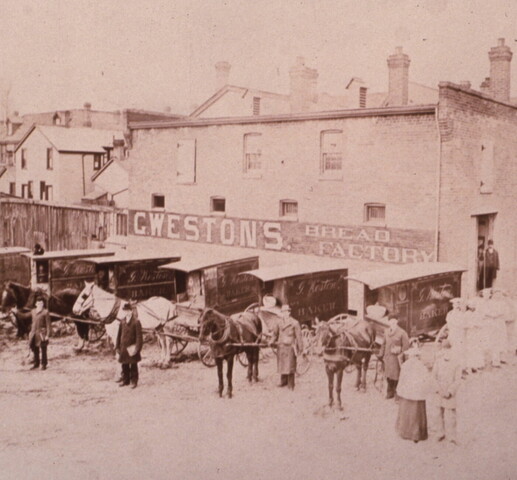
Good Eats: Weston’s Model Bakery
George Weston
George Weston’s Bread Factory, Sullivan Street, 1890. Courtesy of the Toronto Reference Library.
Weston Model Bakery, Soho and Phoebe Streets, ca. 1899, Courtesy of the Mercantile & Financial Times.
Weston Biscuit Factory employees prepare a shipment of biscuits for overseas Canadian troops during World War I. Richmond and Peter Streets. 1915. Courtesy of the City of Toronto Archives.
George Weston with his family. 1905. Courtesy of the Toronto Reference Library.
A bread revolutionary
When George Weston took his first job as a delivery boy for Bowen’s Bakery in Toronto in 1876, he had no idea he would go on to reshape Canada’s bread industry. Born in Oswego, New York, in 1864, Weston moved with his parents to Toronto at a young age. To help his family’s finances, George took on the role of bread delivery boy, a common occupation for young boys at the time. Even by the late nineteenth century, Toronto’s baking industry was fairly small scale. Most bakeries or confectioners supplied baked goods only to their local neighbourhoods and markets: few had the resources to sell bread across the city. This meant a comparative large number of bakeries to serve a modest population. In 1867, when Toronto’s population was approximately 180,000, city directories listed 29 bakers and and 24 confectioners operating in Toronto.
The model bakery
As a young man, George Weston remained in the bread business. In the 1880s, he bought Bowen’s Bakery, the company he had worked for as a boy. George Weston hoped to revolutionize the bread industry by building a state-of-the-art bakery that could produce bread more quickly than his Toronto competitors. In 1897, Weston opened a new bakery on the corner of Phoebe and Soho Streets. Weston called it his “Model Bakery”, hoping the building would serve as an example of the future of baking.
The two-storey building was built for a staff of 40 men and women and was designed to standardize the bread-making process for maximum efficiency. The second storey was devoted to mixing and proofing the bread dough, a process done in large mixing machines. Once the dough had been formed and shaped, it slid down rollers to the first floor, where the loaves were placed in large brick ovens to bake. The Model Bakery also prioritised food safety and hygiene. Long before any city statute required doing so, the Model Bakery included bathing and dressing rooms for employees; all were required to wash before and after every shift.
The Weston Biscuit Factory
Dedicated to his business, George Weston and his family lived above the Model Bakery in a small apartment. It was there that the couple’s first son and eventual heir, Willard Garfield Weston, was born in 1898. By 1900, George Weston’s bread was being shipped to over 30 towns and cities throughout Ontario. But by June 1911, Weston’s Model Bakery was closed. George Weston had turned his attention to another product: biscuits (also known as cookies).
George Weston built a new biscuit factory just a few blocks away from the Model Bakery, on the corner of Peter and Richmond Streets. Weston faced stiff biscuit competition in Toronto, largely due to rival biscuit-maker Christie, Brown & Co. (often known as Mr. Christie). But Weston was persistent: he organised salesmen to go door to door, offering free samples of Weston Biscuits. Bright, colourful wagons advertised Weston’s vanilla wafers daily on the streets of Toronto. Although moderately successful, the Westons never fully displaced their Mr. Christie rivals in Canada’s biscuit wars. But George Weston Ltd. had its sights set on a larger prize.
George Weston Limited
When George Weston died suddenly in 1924, his son, Willard Garfield Weston, was ready to take over the business. As President of George Weston Limited, he took the company public and undertook a campaign to expand the business both throughout Canada and across the globe. W. Garfield Weston helped Weston’s become the largest biscuit manufacturer in England in the 1930s. The company’s further growth saw the acquisition of Canadian grocery store chain Loblaw’s Groceterias Co. Ltd. as well as increasing range of food brands and retailers. Today, George Weston Limited is worth over $40 billion dollars; George Weston’s family continues to own a majority share.

